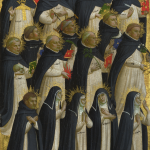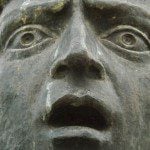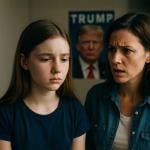In 2014, I’m reading and blogging through Pope Francis/Cardinal Bergoglio’s Open Mind, Faithful Heart: Reflections on Following Jesus. Every Monday, I’ll be writing about the next meditation in the book, so you’re welcome to peruse them all and/or read along.
In this chapter of Open Mind, Faithful Heart, Pope Francis explains the Book of Revelation of following a kind of dream logic.
We cannot enter into these *figures* just by interpreting them allegorically or by representing them conceptually. They are visions, the kind of visions we have in dreams. When we dream, we are mysteriously and forcefully moved by images and feelings that arouse in us powerful figures and forms.
And, when he describes some of the visions of the book, they are so full of images, that they would be contradictions in the waking world.
The image of the Lord is that of the priest (tunic and cincture), at once both old (white hair) and young (feet of burnished bronze), standing in the middle of his Church and carrying out his priestly mission. The Lord takes the firm stand of a judge, his gaze purifies and attracts as does the sun when it shines at its brightest; his voice is heard by all and discerns like a two-edged sword.
Although this vision is intended to clarify, it’s so overstuffed with signs that I can only picture it piecemeal. I’m reminded of a scene from the musical Fun Home, when young Alison is trying to draw a picture of her family for school, and tries to put everything in.
Okay, so: This is a keystone because Pennsylvania is the Keystone State. Inside this square? That’s Beech Creek, see? Bridge, ford, creek, school, Fun Home, our house, Aunt Jane and Uncle Randy’s house. This is Germany. Oh! John, Christian, me. See? Floating in bubbles because we’re not born yet –
Her father’s aggressive reworking of her drawing is less confusing, but he’s lost the expansiveness that is the actual content of what she draws.
As is so often the case, considering theology makes me think about topology. In order to get my head around a Klein bottle (every cool thing about a Möbius strip, but scaled up), I usually start by thinking about each of its properties in isolation. When I try to picture them all at once, my first images are a bit muddled, and tend to leave something out.
Even the real-life instantiations of Klein bottles aren’t quite enough to get me to a full understanding. It’s easy for me to become focused on one specific example, and to mix up which parts of the Klein bottle are essential to it, and which are the window dressing of my visualization. The first time I saw a Klein bottle cup like the one below, I was confused, since I’d inadvertently (guided by the glass and hat examples at the top), thought of the bottles as being bell-shaped in a particular way that was not required.
It’s helpful for all the images I encounter to have something jarring or crowded about them, so I don’t feel that I’ve mastered the idea by approximating it. John’s Apocalypse preserves this sense of learning and lacking, with its dense and vivid visions.














